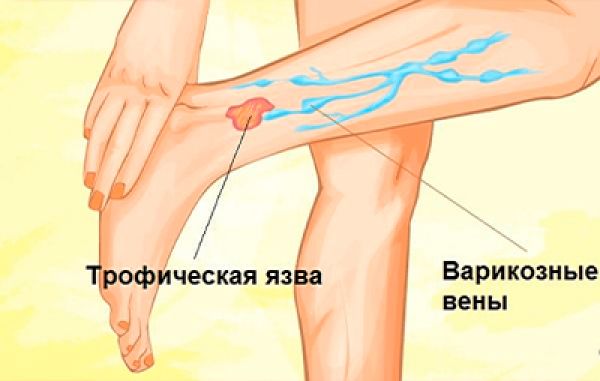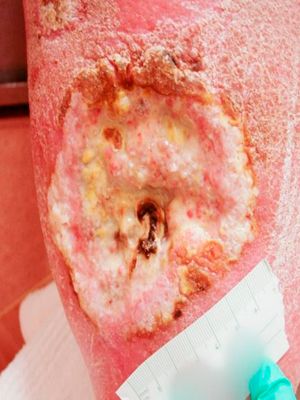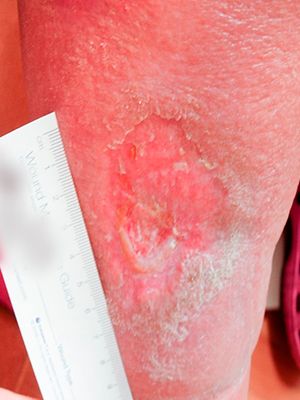- Usage
- Usage Cases
- Venous Stasis Ulcer
Case №34
Venous Stasis Ulcer
Age of Wound: Approx. 3–4 months
USA
-
Gender:
Woman
-
Age:
43 years
-
Diagnosis:
Venous Stasis Ulcer
Trophic venous ulcer - what is it?
A trophic venous ulcer is a long-term non-healing defect of the skin surface resulting from a violation of local innervation, lymph and blood flow. The disease is protracted (usually more than 1 month and up to several years), with periods of exacerbation.
It looks like a venous trophic ulcer

Causes of the appearance of a trophic ulcer on the leg
A trophic ulcer is always accompanied by another serious illness. Diseases that contribute to the appearance of trophic ulcers:
- Neglected stage of varicose veins
- thrombophlebitis
- atherosclerosis
- diabetes mellitus
- Hypertension
- Burns, frostbite
- Arsenic or chromium poisoning
- Radiation exposure
- Spinal cord and peripheral nerve diseases
- complicated tuberculosis and syphilis
- Blood diseases
- Prolonged immobility due to trauma (bedsores)
- complicated diseases of the skin, including allergic ones
Mirragen - a remedy for the treatment of trophic and chronic ulcers at different stages
Trophic ulcers are considered the main problem with varicose veins, diabetes and long-term non-healing wounds. Mirragen can significantly shorten the healing and regeneration of tissues.
Pharmacological action Mirragen.The special structure of Mirragen promotes the growth of soft tissues in the space of the wound channel. This simulates a fibrin clot to stimulate the successive healing of vascular ulcers. The tool "captures" platelets and other components that are involved in wound healing. Borate fibers are mixed with wound exudate, in the process ions are released, which stimulate the following processes:
- Enhanced growth of soft tissues, blood vessels;
- Enhanced blood flow to the damaged area is provided;
- Improves the absorption of trace elements;
- The growth of enzymes, fibroblasts is stimulated.
Due to these properties, the drug is successfully used in various branches of surgical interventions - orthopedics, transplantology, laser surgery.
Indications for use Mirragen
In addition to helping with chronic ulcers and wounds, Mirragen dressing is also used to heal skin and soft tissue injuries and ulcers caused by the following:
- Infected surgical wounds.
- Diabetic foot
- Healing of non-globular and small-globular ulcers on the legs with varicose veins.
- Treatment of pressure sores
- Regeneration of fresh wounds and surgical incisions.
- Healing burns of I and II degrees
Mirragen Terms of Use
It is necessary to apply Mirragen in compliance with all the rules and requirements of asepsis and antiseptics in sterile conditions, that is, in a hospital. For effective action, the primary surgical treatment of the wound channel is preliminarily carried out, that is, the necrotic tissues are truncated, excess moisture and purulent contents are removed.
Mirragen is available as a gauze-based matrix. To apply to the wound, it is necessary to cut a piece of the required size and completely close the wound channel with it. If you need to treat a large wound, you can additionally use sterile gauze napkins.During the integration of Mirragen into the open tissue of the wound, some visual changes are observed:
- Mucus production;
- Uniform deepening of the matrix into the thickness of soft tissues
- Granulation tissue is formed.
Sometimes the matrix is displaced during the granulation process, this can reduce the effectiveness of the healing process, so it is very important to apply the dressing correctly from the beginning.Mirragen dressing is applied daily for 3-4 days. Further, within two weeks, the regularity decreases to once every three days. Subsequently, the condition of the dressing is checked at intervals of 3-5 days and, if necessary, it is replaced.Some redness may occur during the healing process with Mirragen Matrix. This is normal. Discoloration of the matrix is sometimes encountered on contact with the wound surface. Dry skin edges can look too dry and chapped.
Removing Mirragen from a wound
Since the structure of the agent completely dissolves in the content of the wound channel, there is practically nothing to remove. If necessary, after the completion of the treatment course, the wound is washed, all remnants of Mirragen parts or fibers and gauze dressing are washed off.
Cooperate With Us
or via contact phones or email
-
Conveniently
By contacting only one supplier, our customers receive a wide range of products in the shortest possible time.
-
Simple
Our customers are only required to form an order for the supply of products, we will take care of all further tasks
-
Profitable
We save our customers money on import
and delivery taxes



